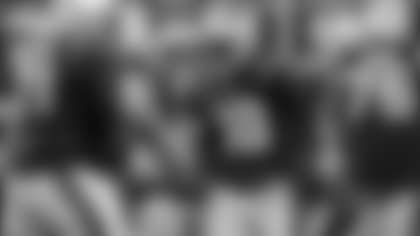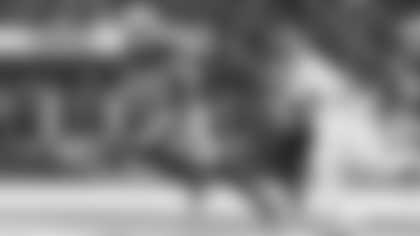The quarterback discourse you're about to hear all week long is an age-old argument surrounding the risk-reward of playmaking at the position.
Over the last two weeks, the Patriots have blown out the Lions and nearly pulled off an upset at Green Bay with rookie backup Bailey Zappe playing mostly turnover-free football. After turning the ball over eight times in their first three games with Jones, the Pats only turned the ball over twice over the past two weeks.
By taking care of the football, New England's offensive efficiency is better with Zappe (+0.076 EPA per play, 12th) than with their starting quarterback under center this season (-0.025, 15th).
However, along with the context of a full game against a struggling Detroit defense, another layer of game-managing is going on that speaks to the ceiling of a Zappe-led offense.
With the rookie at quarterback, the Patriots have played an entirely different brand of offense where Zappe hasn't been asked to do much. The Pats coaching staff has made things easier on the first-year QB through play-action and avoiding tight-window throws.
| STAT | Mac Jones | Bailey Zappe |
|---|---|---|
| Avg. Target Depth | 10.4 | 7.1 |
| Tight Window % | 26.8% | 16.7% |
| Play-Action % | 10.8% | 37.5% |
On Zappe's 40 drop-backs this season, he has attempted only six tight-window throws (16.7%), and the rookie has yet to complete any balls into tight coverage. His average target depth is 7.1 yards, 37.5 percent of his passes have come off play-action, and Zappe was only pressured on two of his 22 drop-backs against the Lions. Compared to what they asked from Jones, as you'd expect, it's apples to oranges.
To Zappe's credit, he has handled what the coaching staff has asked of him well. The Western Kentucky product is averaging 12.1 yards per pass attempt off play-action, making in-rhythm throws to open first-read receivers as he does above on the double post-crosser concept.
Zappe has also operated well in the quick game. For example, the Pats present him with a quick throw to Hunter Henry by clearing the sideline for the underneath route to Zappe's right. This is good ball placement, with Zappe throwing to Henry's inside shoulder to shield him from the squatting cover-two corner on the boundary but far enough away from the inside defender as he sits between the zones.
With five passing plays of 20-plus yards with Zappe, he has mostly found downfield success throwing to crossing routes that stress single-high coverages off play-action. But he made a great read to recognize the split-safety coverage and found Jakobi Meyers in the cover-two hole for six on Sunday.
There are positives to take away from the two games we've seen with Zappe. But heading into the season, the Patriots acknowledged that this style of offense wasn't moving the needle.
New England recognized that it couldn't keep up on the scoreboard if it continued to design conservative game plans with a quarterback shying away from aggressive-minded decisions.
"Mac coming out of college, he had some big plays downfield and had some receivers who could get downfield and he could get the ball out to them and throw some really accurate passes. For us, as we worked through the spring and training camp, that's been something we are trying to do," Senior Football Advisor Matt Patricia told Patriots.com.
Zappe, similar to Jones at times in his rookie season, isn't always pulling the trigger to open receivers who are uncovering downfield. Instead, he's taking the safer throws and thus leaving bigger plays on the field. Even if that means limiting turnovers, it doesn't necessarily make it a good thing.
Ultimately, the Patriots want to compete for championships. Although five interceptions outweighed the positives from Jones's first three starts, the direction they were moving in had the bigger picture in mind that a low-risk offense wasn't competitive against elite teams in the NFL.
Making things easier through good schemes and play calls is nice, but it can't be the only option. Not every throw can be to an open receiver, and even the best offensive minds need their quarterback to make things happen on their own.
Certainly, Jones and the Patriots need to find a better balance between hunting for big plays in the passing game and protecting the football when he returns to the lineup. And maybe some elements, like more play-action, can be useful moving forward. But the Zappe script is harkening back to where they were last season, and we all saw how that ended.
If the Patriots want to compete with the Buffalo's and Kansas City's late in the season, New England needs a playmaker at quarterback. It's good enough to beat the Lions at home when the defense pitches a shutout, but it won't be good enough against better opponents.
Here are three more takeaways and quick-hit notes from Patriots-Lions after further review:
1. Pats Defensive Front Controls Line of Scrimmage vs. Lions Offensive Line
In a heavyweight matchup in the trenches, the Patriots defensive front made a statement against one of the league's best offensive lines. New England held an explosive Lions rushing attack to an average gain of 3.9 yards by their running backs and didn't allow any rushes over 20 yards (Detroit had five in their first four games, second-most in the NFL).
But the dominant wins came in the pass rush, where the Pats defense pressured Lions quarterback Jared Goff on a season-high 41 percent of his drop-backs in Week 5.
The Pats are generating a pass rush this season by scheming up one-on-ones for their edge rushers, mainly Pro Bowler Matt Judon, who had a game-high seven QB pressures and two sacks.
In obvious passing situations, New England often goes to a five-man rush where they occupy the interior of the offensive line with three-man stunts.
On Judon's strip-sack that led to a touchdown, the Pats have stand-up pass-rushers Mack Wilson and Josh Uche in-line over the guards. Along with Christian Barmore rushing over the center, Wilson and Uche run a three-man game that also draws the running back in blitz pickup, meaning the Lions have four blockers to three rushers on the inside. The interior stunt creates one-on-one opportunities for Judon and Deatrich Wise, who beat tackles Taylor Decker and Penei Sewell, with Judon chasing down Goff after the Lions QB tries to break the pocket to kick-start the fumble-six.
For those asking where Christian Barmore is, the second-year defensive tackle often plays the role seen above in their pass-rush schemes. His primary job is to occupy blockers and penetrate the line of scrimmage to get others free to the quarterback, and he does it well.
There's a reason why Judon and Wise are among the NFL's best sack duos, and that's because they are getting the majority of the one-on-one pass-rush reps and winning often enough.
2. Standout Plays in Pass Coverage by the Patriots Secondary
Although the pass coverage was aided by a great day from the defensive front, the Patriots secondary had some excellent reps in both man and zone coverages on Sunday.
After trending towards a zone-heavy defensive system over the last calendar year, recent game plans see percentages leaning back towards man coverage, with an even 50-50 split this week (17 coverage snaps in man, 17 coverage snaps in zone vs. Lions).
Here's a terrific rep in a man-free scheme with the single-high safety as the lone help defender against a two tight end set (12 personnel).
The Lions run play-action to stress the post-safety, but Kyle Dugger (on Hockenson) and Jack Jones (slot) play their technique perfectly. With the deep safety, the two Pats DBs use trail technique where they play slightly underneath and towards the outside hip of the receivers. Their leverage allows them to undercut the crossing patterns, with Devin McCourty helping over the top, and Goff has to throw into tight coverage.
Along with playing tight man coverage, rookie Jack Jones made one of the play's of the game in zone coverage to take away a scoring opportunity for the Lions in the first half.
The Patriots are leaning more on quarters or cover-four zone defense when opponents are in the high red zone (NE 18-yard line here). Likely expecting a single-high structure, the Lions run a post-wheel concept to flood the deep third. However, Jones makes an excellent read to come off the post route, passing it to McCourty, and gets over the top of Hockenson's wheel route that is already being carried well by linebacker Jahlani Tavai. With Tavai in a good position to prevent a completion, Jones goes for the ball and comes up with his second career interception.
New England's pass defense is now eighth in Football Outsiders' DVOA efficiency metric through five weeks, with Jones emerging as a ball-hawk in the backend.
3. Breaking Down the Patriots Offenses' Issues in the Red Zone
After failing to score on four trips this week, the Patriots offense is now scoring a touchdown on just 40 percent of their red zone drives, 28th in the NFL, and obviously, that needs to improve.
Like most things in a team sport, there isn't one thing we can point to that explains everything, so we'll need to drive-by-drive to understand where the miscues are occurring.
As we broke down in the opening section, the first two drives were more on execution than play-calling. On the first drive, Zappe quickly threw a second-down pass to Damien Harris in the flat against a cover-two corner for a minimal gain, then missed an open Meyers for six. In New England's second red zone drive, they had 2nd-and-1 from the DET 12-yard line and couldn't pick up a first down due to run-blocking issues (blown block by Cole Strange followed by a missed assignment on the right side).
We'd put more of the blame on the last two red zone possessions on play-calling, but maybe the coaching staff was already playing ultra-conservative at the point with the game in hand.
Still, their third red zone drive sputtered out quickly when unofficial play-caller Matt Patricia called the following sequence:
- Zone-read run (yes, with Zappe at QB).
- Play-action screen to the running back.
- A wide receiver screen that appeared to be a miscommunication (nobody blocked for Bourne). The wide receiver screen to Bourne might've been checked into by Zappe.
On their final red zone drive, the Patriots called a jet sweep to Bourne (negative play), a same-side crack toss (one too many times), and another zone-read rushing attempt.
There isn't one easy answer here. The Patriots had poor execution on several plays and some questionable play calls on others in the red zone. They have to clean that up.
4. Quick-Hit Notes From Patriots-Lions Film Review
- The Pats had more run-blocking breakdowns than the numbers suggest. The blockers didn't always seem to be on the same page, including a few plays where Rhamondre Stevenson got the ball and was immediately met by an unblocked defender. The Pats offensive line did have some great reps of pin-pull and the same-side toss play that worked until it didn't on the final attempt.
- Stevenson was outstanding, gaining 111 of his career-high 161 yards after contact and avoiding nine tackles. One of those games where the majority of the yards should be credited to the running back. Feed him.
- Jakobi Meyers was back, and it looked like that knee injury was a thing of the past. His routes were crisp and sudden. Overall, Meyers caught four passes for 62 yards against man coverage. The Lions couldn't cover him.
- There were a few instances where rookie WR Tyquan Thornton was open deep. When he gets off the line quickly and changes speeds at the top of his routes, his sudden acceleration is a handful for corners. The downfield targets will come in time.
- TE Hunter Henry had his best game of the season. His routes were much more efficient. Plus, his run-blocking is improving. Maybe he was dealing with an injury or something in the first month of the season—just a thought.
- Credit to LB Jahlani Tavai, who has had a solid two-week stretch here. Tavai, including the Jones INT shown earlier, had some great reps in coverage and made two stops. He plays both on and off the line. Tavai has gotten a lot better since the summer.
- It's good to see third-year linebacker Anfernee Jennings playing well. He was a decent strong-side edge setter, chased down a play from the backside, and even shed a block by Sewell with his hand in the dirt. Uche was good as well (four hurries).
- LB Mack Wilson struggles with play recognition against the run, but he should play on passing downs. Wilson can cover, rush the passer, and spy quarterbacks effectively.
- NT Davon Godchaux took tons of double teams on the chin in this one. He deserves credit for their success against the run, especially that first fourth-down stop.










































